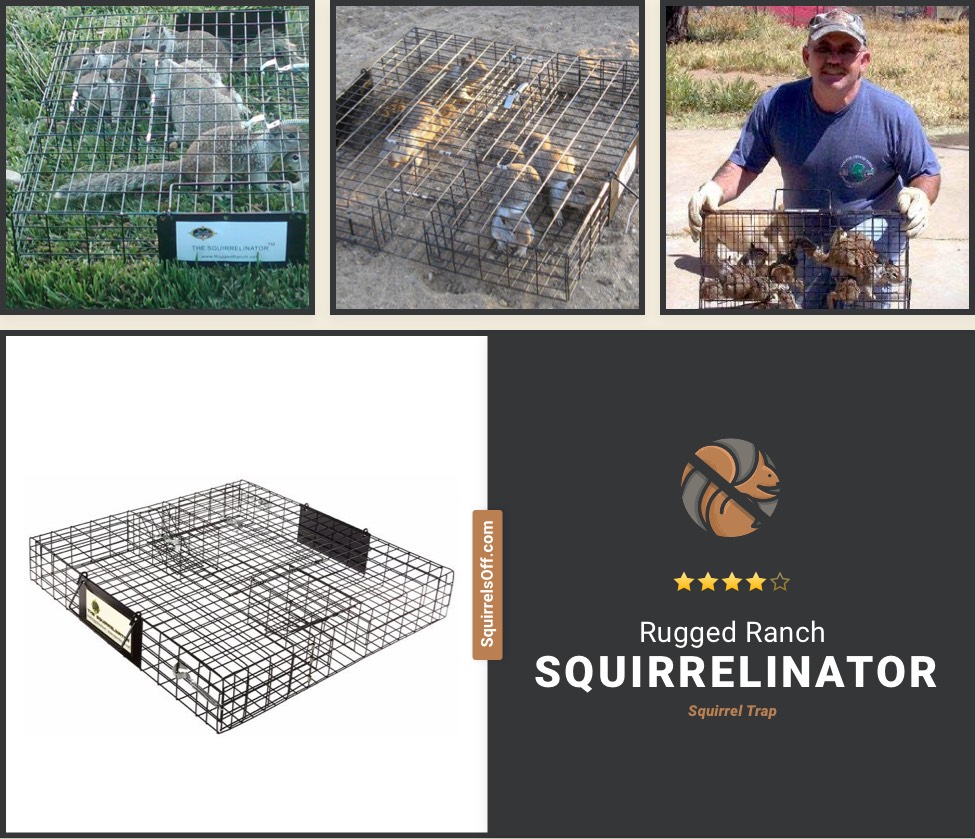Once you find yourself becoming overrun with squirrels, and various other pests, you may be in need of a way to trap and rid your yard of rodents. If this sounds like you, you have come to the right place. While they may be annoying, squirrel problems can be dangerous and costly. These rodents are also well-known carriers of parasites and a variety of diseases.
Although squirrels can seem harmless, they are capable of causing a good deal of damage to your property. Removing squirrels, through the use of a live trap, is the most humane way to combat them. You will need traps if you are looking to get rid of squirrels in a reliable way, and I have the answers you need.
What Kinds of Squirrel Traps are There?
1. Live cage traps
Designed to catch squirrels alive, box or live traps are typically used in areas where a small numbers of squirrels require removal from around your home. They are normally baited with berries, nuts, peanut butter or pieces of fruit to attract squirrels, and are placed by burrow openings and along trails. After a squirrel has been caught, it should be relocated based on state-regulations in an area where it won’t become a nuisance to someone else. Ensure you consult property owners, etc., before releasing any pests. It is also important to understand your state laws in regard to capturing and releasing wild animals, before attempting to use live traps.
2. Snap traps
While most commonly used for catching mice and rats, snap traps work on squirrels as well. You simply apply a thin layer of bait to the trigger, set it where squirrels are known to run, and wait. You may also place them in areas where you’ve noticed gnawing on things such as patio furniture, decking, and wiring. 99% of the time the traps kill squirrels instantly, and it won’t be long before you begin catching them.
3. Tube traps
Squirrels are naturally curious and known to poke around inside everything they discover. Tube traps work on this curiosity, by utilizing snap traps inside round metal, or plastic, tubes. You may lure them in faster with a bit of bait but, either way, they will trigger the trap once they go inside and be killed quickly.
4. Electric traps
Electric traps use electricity to electrocute squirrels, by emitting a deadly high-voltage shock once they enter. Typically squirrels die within a manner of seconds, so the trap is described as relatively humane.
Best Squirrel Trap

Rugged Ranch Squirrelinator Trap
The best trap I’ve used on squirrels to date, the Squirrelinator utilizes a one-way door they cannot escape. It is capable of holding large numbers of squirrels, as well as holding 25 squirrels, once they. This trap doesn’t have a “trip”, simply set up a trail of peanuts and, once they walk through the door, they will all be trapped inside.
Because squirrels naturally want to explore, their curiosity will lead them through the double trap doors as they push their way inside. This design has the added benefit of being able to stay active for extended periods of time, before you are required to empty it. All around, this is a great squirrel trap that is quite easy to set. While it won’t catch the smallest juvenile red squirrels, it works well with adult red squirrels and gray squirrels, alike.
Squirrel Trap Bait
Squirrels enjoy a large variety of food and, while foods that attract them most include nuts and seeds, you may also utilize grains, herbs, fruit and even soft vegetables. Although it seems obvious, you may use birdseed to bait squirrels, especially if they’ve already been stealing it from your bird feeder.
I have tested numerous squirrel trap bait, but the best one to date is peanut butter, hands down. I have taken peanut butter rolled in peanuts, to create a ball of peanut coated peanut butter, which seems to work within a few hours. You may also create a trail of peanuts, leading directly into the trap, with a smear of peanut butter on the trip in order to draw them in.
Setting the Trap
Make sure to set the trap up on a flat surface, directly along the squirrels path. This may be observed at the base of a tree, in an attic, or along walls close to your bird feeders. It’s important that your trap doesn’t wobble, as this will only discourage squirrels, which may be prevented by anchoring it down with a heavy object. Early detection of a caught animal is key, to ensure it doesn’t suffer long, so make sure to check your traps frequently once it’s set.
Tips
- Research your local laws before trapping any squirrels for release or relocation.
- Anchor traps with heavy objects when trapping squirrels outdoors, to prevent animals from stealing bait and tripping the trap over.
- Disinfect traps after each use, to prevent spreading bacteria and illnesses.
Are Squirrel Traps Legal?
While squirrel traps are legal, they may only include particular types of squirrels, such as ground or eastern fox squirrels. Live cages also carry their own catch-and-release laws that vary from state to state. Contact your local authorities in regard to the dispatch or euthanizing of locally caught squirrels.
Learn more about squirrel-proof bird feeders at SquirrelsOff.com
Can I Touch Dead Squirrels?
It’s safest to put a pair of gloves on, in order to protect yourself from any possible infections, before getting dead squirrels out of traps. The corpses of dead rodents can pose hazards to our health, as well as the health of family pets and other wild animals. Take care to place the corpse in a bag that can be sealed tightly for disposal.
- 10 Ways to Squirrel Proof a Bird Feeder - February 7, 2020
- How to Keep Squirrels Out Of Bird Feeder - January 2, 2020
- How To Get Rid Of Squirrels - January 1, 2020

